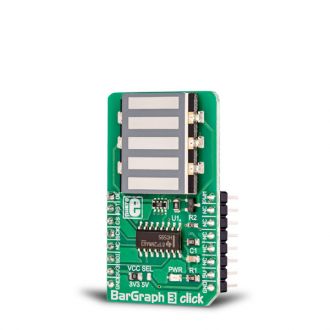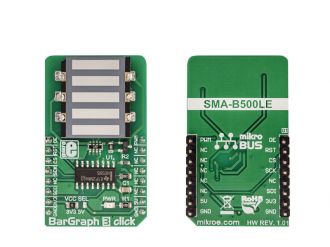
We strongly encourage users to use Package manager for sharing their code on Libstock website, because it boosts your efficiency and leaves the end user with no room for error. [more info]

Rating:
Author: MIKROE
Last Updated: 2018-12-07
Package Version: 1.0.0.0
mikroSDK Library: 1.0.0.0
Category: LED segment
Downloaded: 4799 times
Not followed.
License: MIT license
BarGraph 3 click is equipped with a five-segment LED bar graph display, notable for its strong and reliable illumination of the segments.
Do you want to subscribe in order to receive notifications regarding "BarGraph 3 click" changes.
Do you want to unsubscribe in order to stop receiving notifications regarding "BarGraph 3 click" changes.
Do you want to report abuse regarding "BarGraph 3 click".


Library Description
The library initializes and defines SPI bus driver and drivers that offer a choice for writing data in registers and reading data from registers. The library includes functions for logging values on the BarGraph display. The user can enable and disable the chip with the function bargraph3_enable(), which is supported in the library.
Key functions:
void bargraph3_display(uint8_t ctrl, uint8_t dir, uint8_t counter) - Displays functionvoid bargraph3_enable(uint8_t state) - Functions for enabling the chipExamples description
The application is composed of the three sections :
void applicationTask()
{
uint8_t bargraph_cnt;
for (bargraph_cnt = 0; bargraph_cnt <= 5; bargraph_cnt++)
{
bargraph3_display(_BARGRAPH3_INCREASE_LED, _BARGRAPH3_DIRECTION_BOTTOM_TO_TOP, bargraph_cnt);
Delay_1sec();
}
}
Other mikroE Libraries used in the example:
SPIAdditional notes and information
Depending on the development board you are using, you may need USB UART click, USB UART 2 click or RS232 click to connect to your PC, for development systems with no UART to USB interface available on the board. The terminal available in all MikroElektronika compilers, or any other terminal application of your choice, can be used to read the message.